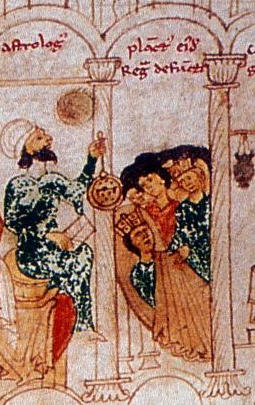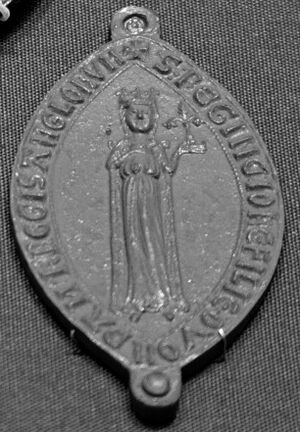Joan of England, Queen of Sicily facts for kids
Quick facts for kids Joan of England |
|
|---|---|
 |
|
| Queen consort of Sicily | |
| Tenure | 13 February 1177 – 11 November 1189 |
| Coronation | 13 February 1177 |
| Countess consort of Toulouse | |
| Tenure | October 1196/7 – 4 September 1199 |
| Born | October 1165 Château d'Angers, Anjou |
| Died | 4 September 1199 (aged 33) Rouen |
| Burial | Fontevrault Abbey |
| Spouse |
Raymond VI of Toulouse (m. 1196/7) |
| Issue | Raymond VII, Count of Toulouse Joan of Toulouse Richard of Toulouse |
| House | Plantagenet / Angevin |
| Father | Henry II, King of England |
| Mother | Eleanor, Duchess of Aquitaine |
Joan of England was a powerful queen and countess who lived a very interesting life in the Middle Ages. She was born in October 1165 and died in September 1199. Joan was the seventh child of Henry II, King of England and Eleanor, Duchess of Aquitaine. Her parents were two of the most important rulers in Europe at the time.
From the moment she was born, Joan was expected to marry someone important. This was common for princesses back then. She married William II of Sicily and later Raymond VI, Count of Toulouse. Both men were very powerful figures in the politics of Medieval Europe.
Contents
Early Life of a Princess
Joan was born in October 1165 at Château d'Angers in a place called Anjou. She was the seventh child of King Henry II and Queen Eleanor. Joan spent her younger years at her mother's royal homes in Winchester and Poitiers.
As a young princess, Joan's education was designed to prepare her for a royal marriage. She probably learned skills like sewing, weaving, singing, and playing music. She also learned to ride horses, which she seemed to enjoy very much. She even mentioned her horse in her will!
Queen of Sicily
In 1176, William II of Sicily sent messengers to England. He wanted to ask for Joan's hand in marriage. The marriage was agreed upon on May 20. Joan's father, King Henry II, had to collect money to pay for her journey and the wedding. He did this by asking for a special tax from his English subjects.
On August 27, Joan sailed from Southampton, England, towards Sicily. She was escorted by important people, including a bishop and her uncle. In France, her older brothers, Henry the Young King and Richard the Lionheart, helped escort her. Finally, she met representatives from the Kingdom of Sicily.
After a difficult sea journey, Joan arrived safely in Palermo, Sicily. On February 13, 1177, she married King William II. She was crowned Queen of Sicily at Palermo Cathedral on the same day.
Joan and King William did not have any children who survived. There were rumors that she had a son named Bohemond around 1181 or 1182, but if he existed, he died as a baby. In those times, if a king didn't have a son, he might end his marriage to try and marry someone else who could give him an heir. However, King William did not do this. He chose his aunt, Constance, Queen of Sicily, to be his heir instead.
When King William II died in November 1189, his cousin, Tancred of Sicily, took control of Sicily. Tancred also took away the lands that William had given to Joan. He did this because one of those lands was important for defending against invaders. Tancred also put Joan under house arrest. This was because she supported Constance as the rightful heir to the throne.
The Third Crusade
In 1190, Joan's brother, King Richard I of England, arrived in Italy. He was on his way to the Holy Land for the Third Crusade. Richard demanded that Joan be set free and that all her dowry money be returned. When Tancred refused, Richard attacked a monastery and a castle. He spent the winter in Italy and even took control of the city of Messina, Sicily.
Finally, Tancred agreed to Richard's demands and sent Joan's dowry. In March 1191, Joan's mother, Eleanor of Aquitaine, arrived in Messina with Richard's future wife, Berengaria of Navarre.
Eleanor then returned to England, leaving Berengaria in Joan's care. Richard decided to delay his wedding. He put his sister and his bride on a ship and set sail. Two days later, a terrible storm hit the fleet. Several ships were destroyed, and Joan and Berengaria's ship was blown off course. Richard landed safely in Crete, but their ship was stranded near Cyprus.
The ruler of Cyprus, Isaac Comnenus of Cyprus, was about to capture them. But then, Richard's fleet suddenly appeared and saved the princesses! However, Isaac managed to escape with Richard's treasure. Richard chased Isaac, captured him, and threw him into a dungeon. Richard then married Berengaria on May 12, 1191, in Limasol, Cyprus. After that, he sent Joan and Berengaria on to Acre.
Joan was Richard's favorite sister. However, he was willing to use her in his political plans. He even suggested that she marry Al-Adil I, the brother of Saladin, a famous Muslim leader. The idea was that Joan and Al-Adil would rule Jerusalem together. Both Al-Adil and Saladin liked the idea. But the plan failed because high-ranking Christian priests strongly opposed the marriage. They even threatened to remove Richard from the Christian Church. King Philip II of France also showed interest in marrying Joan, but this plan also did not work out.
Countess of Toulouse
In October 1196, Joan married Raymond VI, Count of Toulouse, in Rouen. This was Raymond's fourth marriage. As her dowry, Joan brought him lands called Quercy and Agenais. She became the mother of his successor, Raymond VII of Toulouse, who was born in July 1197. She also had a daughter named Joan, born in 1198.
Some writers from that time did not like Raymond VI. They believed he was a heretic, which meant he had beliefs that went against the main church teachings. These writers claimed that Joan's marriage to Raymond quickly became unhappy. They also said that she was trying to escape to her brother Richard's lands in 1199 when she heard that Richard had died.
However, another historical record, "The Chronicle of Guillaume de Puylaurens," tells a different story about Joan's last months. It says that Joan was a very strong and brave woman. After she recovered from giving birth, she decided to fight against the people who were causing trouble for her husband. She even led an army against some lords and laid siege to their castle.
Her efforts did not go well. Some of her own people secretly helped the enemy. Joan was very upset and gave up the siege. She almost got trapped by a fire that the traitors started. Feeling very hurt by all this, she rushed to see her brother King Richard to tell him what happened. But she found out that he had already died. Joan herself died while she was pregnant, overcome by this double sadness.
Death and Burial
Joan asked to be taken to Fontevrault Abbey. This was an unusual request for a married and pregnant woman, but it was granted. She died during childbirth. She was veiled as a nun on her deathbed, which meant she took religious vows just before she passed away. Her son was born by a special surgery after Joan had died. He lived just long enough to be baptized and was named Richard. Joan was thirty-three years old when she died.
Joan was buried at Fontevrault Abbey. Her statue there originally showed her kneeling at the head of her father's tomb. Her hands were together, and her head was bowed in prayer. Her son Raymond was buried next to her, and his statue also knelt facing hers. Sadly, both of these statues were destroyed during the French Revolution.



